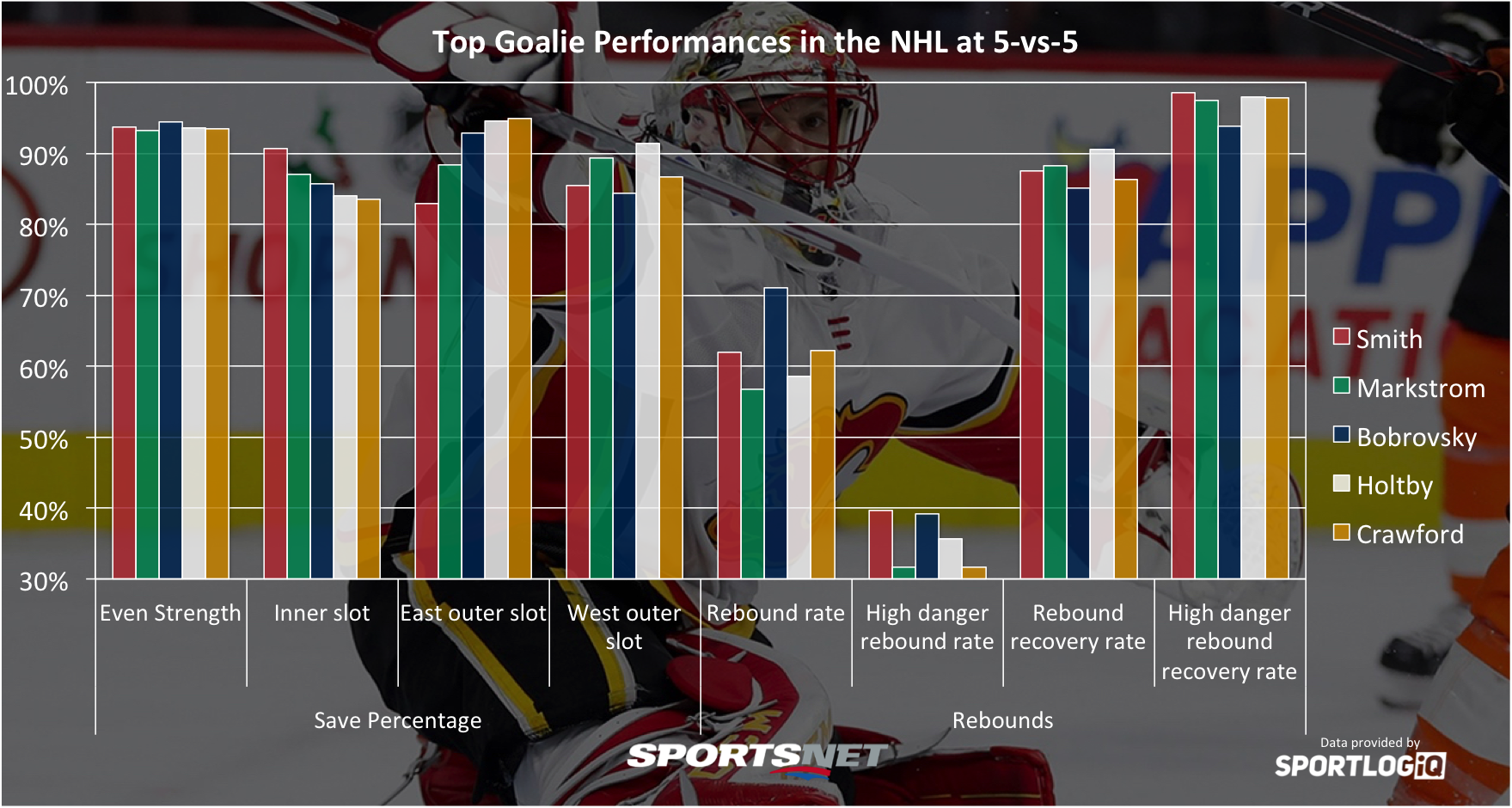After breaking down the top forward lines and defence pairings so far this season, the natural next step is to look at which goaltenders have been the biggest difference makers for their teams.
Unfortunately with goalies there just isn’t the same variety of statistics to evaluate their play that exist for skaters, so it’s a lot tougher to come to a conclusion about total value, especially in small sample sizes.
In the end I decided that sticking to 5-on-5 play made sense once again, because save percentage on special teams is highly unreliable in small samples. In order to qualify, goaltenders had to start at least 10 games this season and I wanted to look at not just overall performance, but signs that the performance is sustainable, and how much the goaltenders themselves are contributing to the shot quality they face.
With that in mind, here’s what I came up with as the top goaltenders through one quarter of the NHL season.

Be aware that in order to increase the contrast in these big numbers I started the y-axis (vertical) at 30 per cent.
Over the past several years of NHL hockey, we know that future overall save percentage is normally best predicted by how well goalies are stopping pucks in the high danger area, or inner slot. So far this season, Mike Smith is leading everyone there by a wide margin, turning away 90.7 per cent of the high danger chances he faces, which is more than 13 percentage points better than league average.
An interesting note on Smith’s high danger save percentage being the highest of this group: his outer slot save percentage is the lowest for him personally and below league average. That’s an odd outlier. Smith gives up rebounds on 62 per cent of the shots he faces, but those rebounds are recovered by his teammates or himself 87.5 per cent of the time.
Smith has a relatively high percentage of his rebounds that wind up in the inner slot area, but 98.6 per cent of those rebounds are either recovered by his teammates or smothered by Smith before opponents get a chance to get on the puck, so it hasn’t burned him yet.
Sergei Bobrovsky, last season’s Vezina winner, leads the NHL in even strength save percentage again, and is third in high danger save percentage while posting stronger save rates in the high slot than Smith. Bobrovsky has been a bit of a mess with rebounds though.
A whopping 71 per cent of the shots Bobrovsky faces result in rebounds, and 39 per cent of those end up in the inner slot. The Blue Jackets also recover fewer of Bob’s rebounds than league average teams do, making things tougher on him as he faces more second chances than other goalies.
That hasn’t burned him yet, but the question for Bobrovsky is whether you credit him for the extra saves or punish him for being the creator of his own increased difficulty? In a small sample size, it’s tough to say which is more important. If by the end of the season Bobrovsky still leads the NHL in even strength save percentage, you just have to tip your hat to him.
Braden Holtby puts up strong numbers across the board, and he doesn’t give up many rebounds either, with only 59 per cent of the shots he faces ending up out of his immediate control. The Capitals also recover among the highest percentage of rebounds in the NHL at 90.7 per cent – and they recover 97.5 per cent of Holtby’s rebounds into the high danger area.
Holtby has the easiest workload of this elite group, but you have to give him credit for helping to ease that by keeping second chances to a minimum.
Corey Crawford remains one of the most consistent even strength goaltenders in the NHL, posting strong save percentages and allowing the lowest percentage of rebounds to the inner slot of anyone.
The Blackhawks don’t recover Crawford’s rebounds at as high a rate as other teams, but Crawford’s own work in the high danger area leads to 97.8 per cent of those high danger rebounds being recovered.
Arguably the most surprising goaltender on this list is Jacob Markstrom, who used to be the ‘Next Great Goalie’ prospect for years, only to flounder in the NHL until this season when he’s been brilliant at even strength for an equally surprising Vancouver Canucks team.
Markstrom boasts the second-best high danger save percentage in the NHL, strong numbers in the high slot, and has the lowest percentage of shots faced that turn into rebounds at just 57 per cent.
Of those rebounds, Markstrom is tied with Crawford for the lowest percentage of them ending up in the high danger area at just 31.7 per cent. Markstrom’s teammates have done a great job recovering the very few rebounds he actually allows, too.
I think you could make a legitimately strong argument for any of Smith, Bobrovsky, and Markstrom as the top-three goalies this season. Whether those will be the same names up for the Vezina at the end of the year, though, is anyone’s guess.
[relatedlinks]







